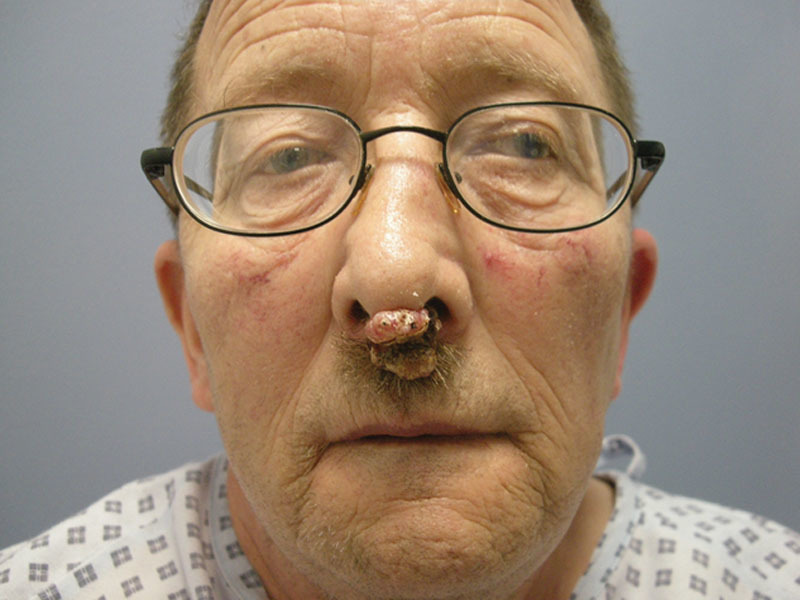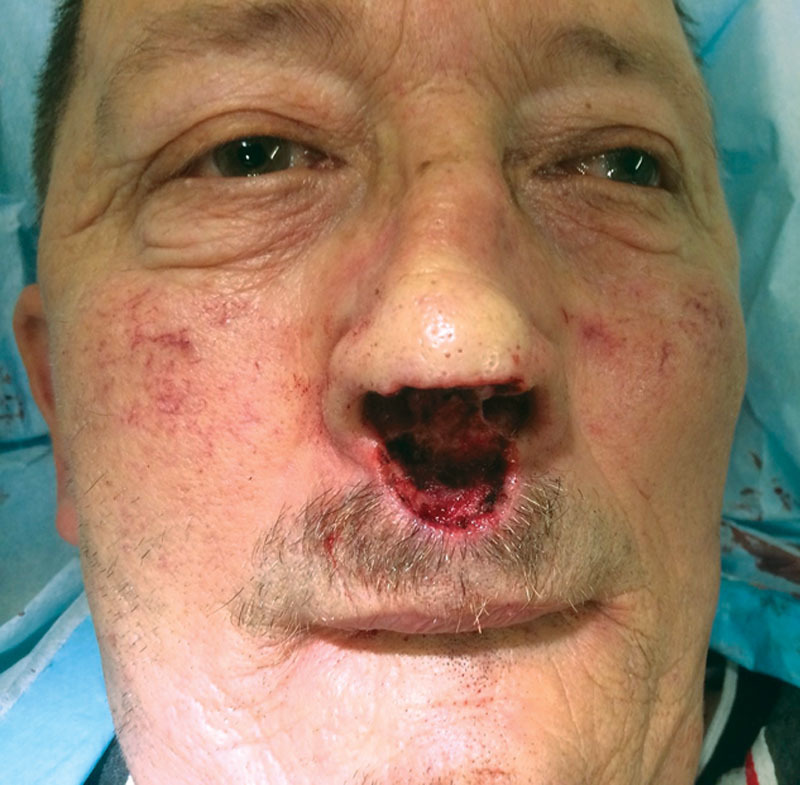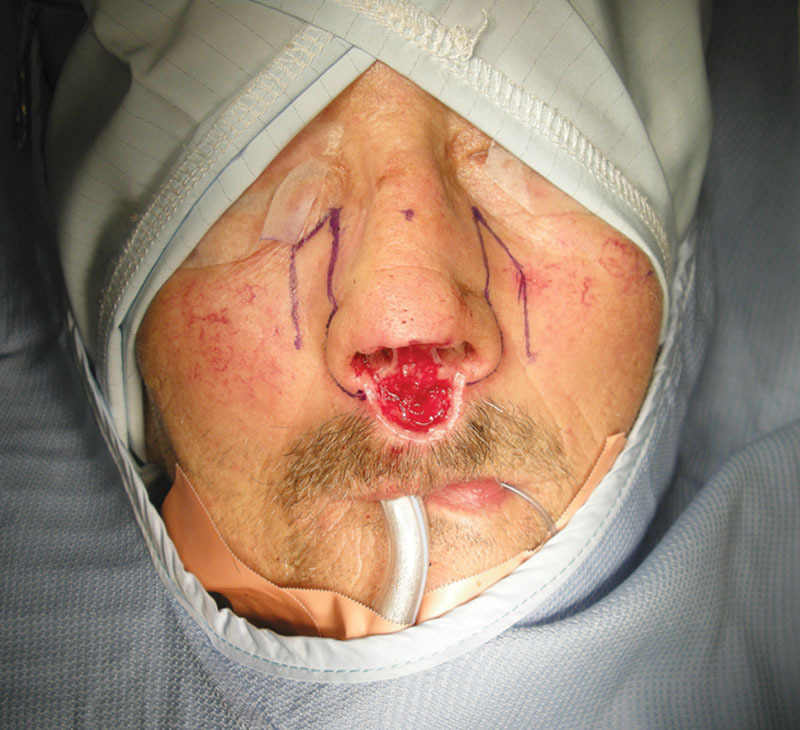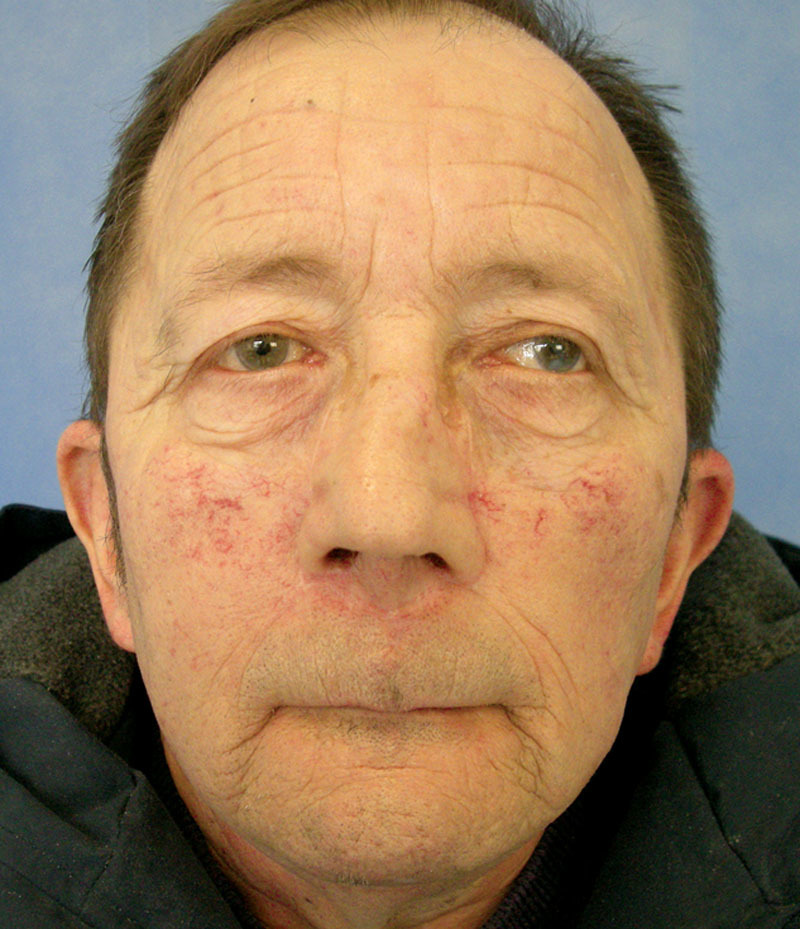Summary:
The use of the nasocheek sulcus flap with a cartilage strut provides an aesthetically pleasing result in total columella reconstruction. This provides thin hairless skin appropriate for the subunit. Mohs surgery aids in limiting the excision to the tumor involved area, providing a complete clearance and conserving precious units, which have an impact on the reconstructive options. The method of reconstruction described here is simple and easily reproducible, providing an optimal result with almost no donor site morbidity.
The columella is unique, and though it is a small unit, its reconstruction poses a challenge to the plastic surgeon. Converse1 considered the columella as one of the most difficult structures to reconstruct. Several techniques have been described for columella reconstruction—composite grafts, local flaps, and distant flaps. A case utilizing the nasocheek flap with a septal cartilage strut is described here.
CASE REPORT
A 61-year-old male patient presented with a mass in the columella, involving the membranous septum and sill (Fig. 1). The result of the biopsy proved this to be a basal cell carcinoma. He underwent Mohs micrographic surgery. The final defect involved the whole of the columella, membranous septum, medial aspect of nasal sill, and the upper medial aspect of upper lip at the base of the columella (Fig. 2)
Fig. 1.

Preoperative picture showing tumor involving columella of nose.
Fig. 2.

After Mohs surgery—defect involving complete columella, membranous septum, medial sill, and upper medial aspect of upper lip.
Flap design as described by Akbas et al2 was done. The columella was formed by the thin pliable tissue of the nasojugal area (Fig. 3). In addition, a septal cartilage graft was harvested from the posteroinferior part of the septum to which there was already access by just elevating the septal mucoperichondrium on either side. This was used as a strut for the columella. The incisions for elevating the flaps on either side resulted in perialar advancement for the reconstruction of the lip defect.
Fig. 3.

Preoperative markings for the nasocheek flap.
The flap showed no area of ischemia or congestion postoperatively. Patient was a smoker but had stopped smoking 2 weeks before the procedure.
At 3 months, a refinement of the sill area was done. The final result was a columella of excellent contour (Fig. 4) with adequate support provided by the septal cartilage strut. The donor site was well hidden at the sulcus.
Fig. 4.

Postoperative appearance—frontal view, the donor site scar is hardly visible.
DISCUSSION
Columella defects can result from trauma, infection, or tumor excision. The columella has always been a difficult unit to reconstruct. There are various methods described in literature. These include composite free graft from ear,3 nasolabial flap, forehead flap, and extended Abbe flap.4
The forehead flap, which is the workhorse for nasal reconstruction, in this case, would have required the lip and sill to be reconstructed as the initial step to provide a base for the subsequent forehead flap. Moreover, this involves a staged procedure with a scar on the forehead. The extended Abbe is useful for a larger upper lip defect. But this is multistage and leaves a scar on the lower lip, which has a high propensity to hypertrophy.
The use of cheek flaps for columella reconstruction has been described earlier as an island flap.5 The method described by Akbas et al1 is ideal for the columella, sill, and membranous septum complex, which may also involve the upper lip. An additional step of adding a columella strut prevents the collapse of the columella postoperatively giving a superior aesthetic result. This can be done in a single stage with almost no donor site morbidity.
ACKNOWLEDGMENT
I thank Dr. John McKenna, Consultant Dermatologist and Mohs Surgeon, Leicester Royal Infirmary for the Mohs procedure performed on the patient, which ensured complete tumor resection with maximum tissue preservation.
PATIENT CONSENT
The patient provided written consent for the use of his image.
Footnotes
Disclosure: The author has no financial interest to declare in relation to the content of this article. The Article Processing Charge was paid for by the author.
REFERENCES
- 1.Converse JM. Reconstructive Plastic Surgery. Philadelphia: WB Saunders; 1977. pp. 1269–1271. [Google Scholar]
- 2.Akbas H, Keskin M, Guneren E, Eroglu L, Demir A. Reconstruction of columella, membranous septum, and upper lip in a single stage operation. Br J Plast Surg. 2003;5:291–292. doi: 10.1016/s0007-1226(03)00098-5. [DOI] [PubMed] [Google Scholar]
- 3.Lewin ML. Congenital absence of the nasal columella. Cleft Palate J. 1988;25:58–63. [PubMed] [Google Scholar]
- 4.Zapater E, Simon E, Ferrandis E, Vendrell JB. Reconstruction of upper lip, columella and premaxilla with an extended Abbe flap: report of a case. Auris Nasus Larynx. 2002;29:305–308. doi: 10.1016/s0385-8146(02)00011-1. [DOI] [PubMed] [Google Scholar]
- 5.Kaplan I, Ben-Bassat M. Grabb’s Encyclopedia of Flaps. 1st ed. Volume 1. Boston: Little, Brown and Company; 1990. Bilateral cheek island skin flaps. pp. 262–263. [Google Scholar]


